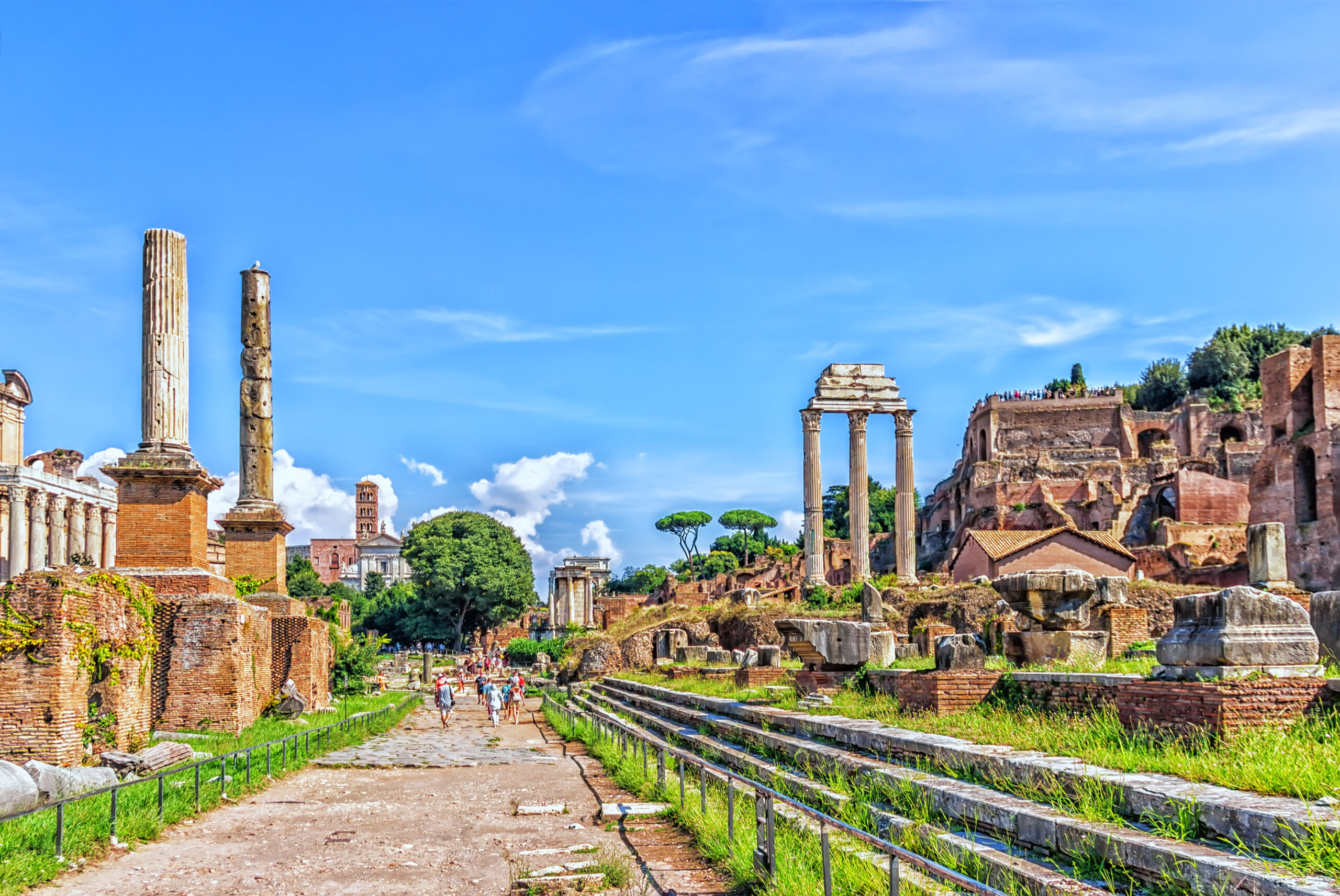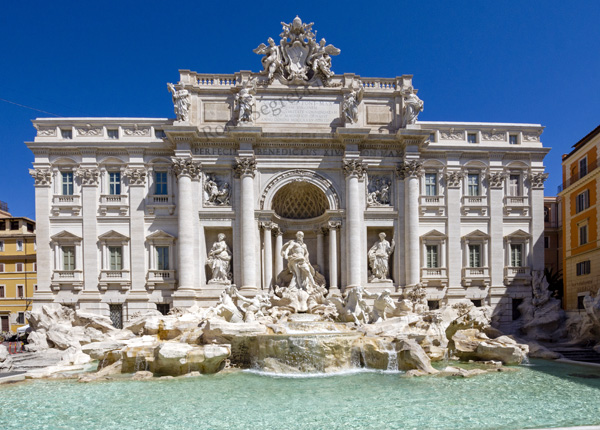Rome, a timeless beauty
The Colosseum: Rome’s Icon
You cannot visit Rome without marveling at the Colosseum, one of the most iconic monuments in the world. This majestic amphitheater, inaugurated in 80 AD, was the stage for spectacular gladiatorial combat and public games. Its imposing structure and fascinating history attract millions of visitors each year. As you stroll through its arches and galleries, you can imagine life in ancient Rome and the grandeur of the spectacles that once took place here.



The Roman Forum and the Palatine Hill: The Heart of Ancient Rome
A short walk from the Colosseum, the Roman Forum and the Palatine Hill offer another dive into ancient Rome. The Forum was the bustling center of Roman public life, home to markets, temples, and meeting places. Today, the ruins of its historic buildings tell the story of a civilization that influenced the entire world. The Palatine Hill, one of Rome’s seven hills, provides a panoramic view of the Forum and the entire city, and is also the legendary site where Romulus and Remus were said to have been raised by the she-wolf.



The Pantheon: A Masterpiece of Architecture
The Pantheon, with its perfectly preserved dome and famous oculus at the center, is one of the finest examples of Roman architecture. Built by Marcus Agrippa and later restored by Emperor Hadrian, this ancient temple is now a church and a burial place for some of Italy’s most significant historical figures, including Raphael. The incredible engineering of the dome, with its oculus allowing natural light to enter, is a marvel that captivates every visitor.



The Vatican City: The Spiritual Center of Christianity
A trip to Rome would not be complete without a visit to Vatican City, the small independent state that hosts the Pope and the most important institutions of the Catholic Church. St. Peter’s Basilica, with its grand dome designed by Michelangelo, is one of the largest and most impressive churches in the world. Don’t miss the chance to admire Michelangelo’s Pietà and to climb the dome for a breathtaking view of Rome. The Sistine Chapel, famous for Michelangelo’s frescoes, is a Renaissance masterpiece that will leave you speechless.



Trevi Fountain: A Symbol of Elegance
The Trevi Fountain is one of the most famous fountains in the world and a must-see during your visit to Rome. Designed by Nicola Salvi and completed in 1762, this Baroque fountain is decorated with sculptures and reliefs representing marine deities and the power of water. Tradition has it that if you toss a coin into the fountain, you will return to Rome. The view of the fountain illuminated at night is particularly enchanting and romantic.



Piazza di Spagna and Trinità dei Monti: A Corner of Beauty
Piazza di Spagna is one of the most vibrant places in Rome, famous for its elegant staircase, the Spanish Steps, which lead up to the Trinità dei Monti church. The square is a popular meeting spot and a great place to stroll, shop in luxury boutiques, and enjoy a gelato. The Barcaccia Fountain, located at the center of the square, is another point of interest not to be missed.


Villa Borghese: A Green Retreat in the Heart of the City
For a break from the city’s hustle and bustle, visit Villa Borghese, a vast public park located in central Rome. This Italian garden features museums, lakes, and tree-lined paths perfect for a relaxing walk. The Borghese Gallery, located within the park, houses an extraordinary collection of artworks, including sculptures by Bernini and paintings by Caravaggio.



Trastevere: A Charming and Lively Neighborhood
Trastevere is one of Rome’s most characteristic and lively neighborhoods, with its cobbled streets, bustling squares, and traditional restaurants. As you walk through Trastevere, you can discover historic churches such as Santa Maria in Trastevere and enjoy the unique atmosphere of its bars and trattorias. It’s the ideal place to savor Roman cuisine and experience the city like a local.



Campo de’ Fiori: Market and Nightlife
Campo de’ Fiori is a lively square that hosts a vibrant outdoor market during the day, where you can find fruits, vegetables, and local specialties. In the evening, the square transforms into a hotspot for nightlife, with numerous bars and restaurants offering food and drinks in a lively and informal setting. Don’t miss the chance to visit this place and enjoy a Roman aperitivo.



The Catacombs: An Underground Journey into History
For a unique experience, explore the catacombs of Rome, an underground network of tombs stretching beneath the city. The Catacombs of San Callisto and San Sebastiano offer a fascinating glimpse into the lives of early Christians and their burial practices. These mysterious and intriguing places provide an opportunity to discover a lesser-known aspect of Roman history.


Piazza Navona: An Example of Baroque Architecture
Piazza Navona is one of the most beautiful squares in Rome, characterized by three spectacular fountains and surrounded by elegant Baroque buildings. The Fountain of the Four Rivers, designed by Gian Lorenzo Bernini, is particularly noteworthy and represents the four major rivers known at the time. The square is also a great place to sit and watch Roman life while enjoying a coffee or gelato.



Vatican Museums: A Treasure of Art and History
In addition to St. Peter’s Basilica and the Sistine Chapel, the Vatican Museums house one of the most impressive art collections in the world. With a vast range of works spanning from antiquity to the Renaissance, the museums offer a unique cultural experience. Among the most famous pieces, you can admire the Raphael Rooms and the Vatican Sculpture Collection.



The Janiculum Hill: A Panoramic View of Rome
For a spectacular view of the city, head to the Janiculum Hill, located west of Rome’s historic center. From here, you can enjoy one of the best panoramas of the capital, with a view extending from ancient monuments to modern buildings. The Janiculum Hill is also a perfect spot for a peaceful walk and to discover lesser-known monuments.



The Mouth of Truth: A Legendary Marble Mask
The Mouth of Truth (Bocca della Verità) is a world-famous colossal marble mask. According to legend, it has the ability to bite the hand of anyone who places it in its mouth. This legendary sculpture, measuring 1.75 meters in diameter, is dedicated to the God of the Sea and is depicted with a bearded face, with eyes, nose, and mouth all pierced.
The Legend Goes…
A husband, distrustful of his wife, brought her to the Mouth of Truth to test her fidelity. The wife pretended to faint, and her lover caught her in his arms. Shortly after, the woman swore before the Mouth of Truth that she had only been in the arms of her husband and the man who had just held her.
This is just one of many legends surrounding this famous sculpture, which, despite the passing of time and eras, continues to intrigue every visitor.

Castel Sant’Angelo
Also known as the Mausoleum of Hadrian, Castel Sant’Angelo is a fortress located on the right bank of the Tiber River, not far from the Vatican. Its construction began in 135 AD, by order of Emperor Hadrian, who intended to use it as a mausoleum for his family. The building process continued until 139 AD, after which it was converted into a military structure. In 403 AD, it was incorporated into the Aurelian Walls complex. Castel Sant’Angelo is divided into five levels, accessible by a spiral ramp that leads to the chamber containing the ashes and to the cells where various notable figures were imprisoned.
As you ascend to the upper part of the castle, you can visit the papal apartments, adorned with perfectly preserved Renaissance frescoes, as well as the large collections of weaponry.
On the top floor, there is a large terrace that offers fantastic opportunities to take stunning photographs of the city from above.



The Altar of the Fatherland
The Altar of the Fatherland, located in the heart of Rome, is an imposing monument dedicated to Victor Emmanuel II, the first king of a unified Italy. Built between 1885 and 1935, the monument is also known as the Vittoriano. Characterized by monumental white marble architecture, the Altar of the Fatherland houses the Tomb of the Unknown Soldier, honoring an unidentified soldier who fell during World War I and symbolizing all Italian soldiers who have died in war. The structure, topped by a large equestrian statue of the king and two bronze chariots, offers a breathtaking panoramic view of Rome from its upper terrace.



The Baths of Caracalla: Relaxation and History
The Baths of Caracalla are a large Roman bath complex that, although partly in ruins today, offers a fascinating glimpse into daily life in ancient Rome. These public baths, built under Emperor Caracalla, featured impressive facilities and are an extraordinary example of Roman engineering.


